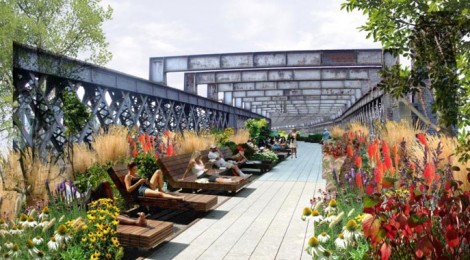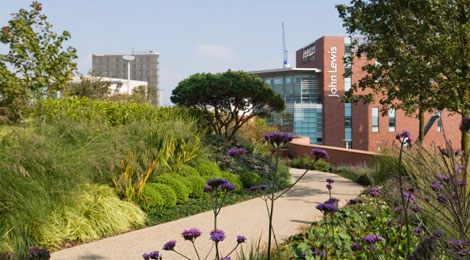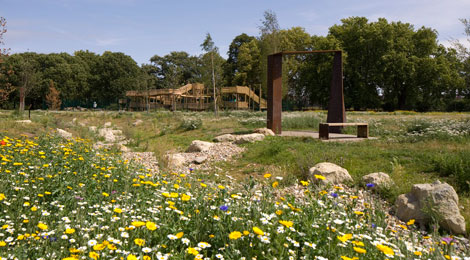
Greening the City
by Darrell Wilson
The idea of ‘greening the city’ has become synonymous with initiatives that increase and enhance the quality and content of nature and the environment within our towns and cities. Along with slogans like ‘Green Infrastructure’ and ‘Green Economy’, the green agenda is at the forefront of government policy across the globe -‘green is definitely the new black’. However, does the term ‘greening’ go far enough to describe the importance that is placed on nature, the landscape and the environment as custodians of our society for future generations?
The symbiotic relationship between urban development and landscape holds a promising future in determining the success of our cities. Continued long-term investment in restoring and reconnecting natural resources into the heart of urban life is the key. This is envisioned through the creation of revitalised river systems, parks and open space networks, supporting natural systems such as flood control, biodiversity and ecologies, and preserving existing ecosystems and topographies.
BDP is at the cutting edge of this debate creating places which not only embrace the beauty and spiritual value of nature but also appreciate the unique context of time and the value that it brings to landscapes ensuring that they evolve and mature gracefully.We see the idea of a living ‘green’ city as being an evolving fabric of differently scaled interactive natural, landscape spaces, all connected together and our work forming different pieces of that fabric.
To the eyes of the man of imagination nature is imagination itself william blake
At the intimate scale, our involvement in groundbreaking initiatives like Manchester Garden City, Dig the City and Peckham Charrettes has embraced a proactive bottom up approach with communities at the core, increasing the awareness and capacity of nature in the city. One exciting vision is to transform Castlefield Viaduct, a beautiful, disused relic of the Victorian steam age into a multifaceted, community owned natural landscape at the heart of cultural Manchester.
Chavasse Park at Liverpool One demonstrates an innovative approach to the provision of open space in the heart of Liverpool’s retail district by placing a 2 hectare park above four levels of a new city centre car park. This takes the concept of a green roof to a new height!
In 2003, mental illness was estimated as a £77.4 billion welfare loss to the UK. Evidence suggests that access to the natural environment promotes recovery from stress and fatigue and improves wellbeing. In the Alder Hey Hospital project there is a blurring of the boundaries between landscape and architecture with the new hospital building located within an existing public park. The form of the building allows the landscape to wrap over it creating a series of green roofs, whilst the fingers of the building open out and create views into the park.
In Beijing, air quality has posed challenges, with levels of nitrogen dioxide, sulphur dioxide and suspended particulate matter that are all above the index averages. The local government has recognised the health economic benefits of trees in removing quantities of O?, PM??, NO?, SO? and has encouraged green spaces and extensive tree planting as one part of the solution. The goal is that a resident will never be more than 500 m from a green space and since 2000, the city’s green areas have risen from 36% to just over 50%. BDP’s masterplanning in China places landscape at the very heart of design. Examples of this are competition winning designs such as Xi’an Jiaotong – Liverpool University, Suzhou, and Suzhou Exhibition Centre, where the architecture has been shaped around well designed and distinctive landscapes which create cooled spaces, sweetened air and dappled sunlight. Such places will grow, evolve and mature over time bestowing improved value in future years.
study nature, love nature, stay close to nature. It will never fail you, Frank Lloyd Wright
In the UK, the Environment Agency revealed the cost of environmental damage from polluted urban wash-off had been estimated at £150-£250 m. Urban trees, SUDS systems and green roofs retain rainwater thereby reducing peak run off. They also filter water effectively and reduce the threat of flooding. The innovative project at Ladywell Fields, London, transformed a park disconnected by a channelised river into a natural flowing environmental asset with the river at the heart. The key to the project’s success was looking cohesively at the whole site and working with nature. The resulting benefits include reduced flood risk, value for money, new connections along the river and a strong new identity for the area, creating one of London’s hidden rural gems.
It was suggested by CABE that ‘switching public spending to schemes such as trees, parks, green roofs and waterways would address climate change more effectively, improve public health and improve communities.’
Encouragingly, professional place makers are moving from theoretical to practical means of responsibly and consciously placing the value of nature at the heart of design. Techniques are being adopted that ensure future development secures the significance of our natural environments by creating healthier places that boost the quality of life for all.



